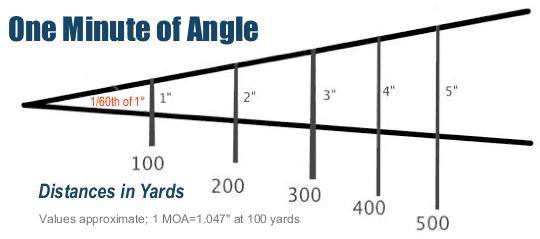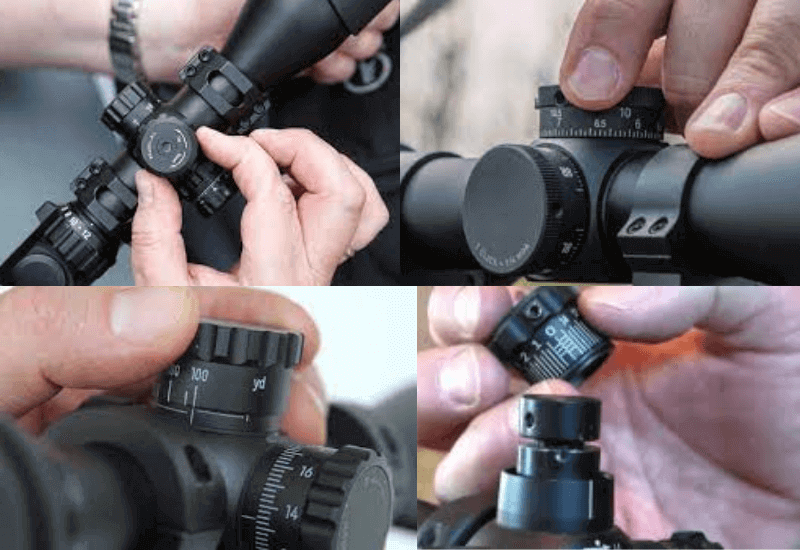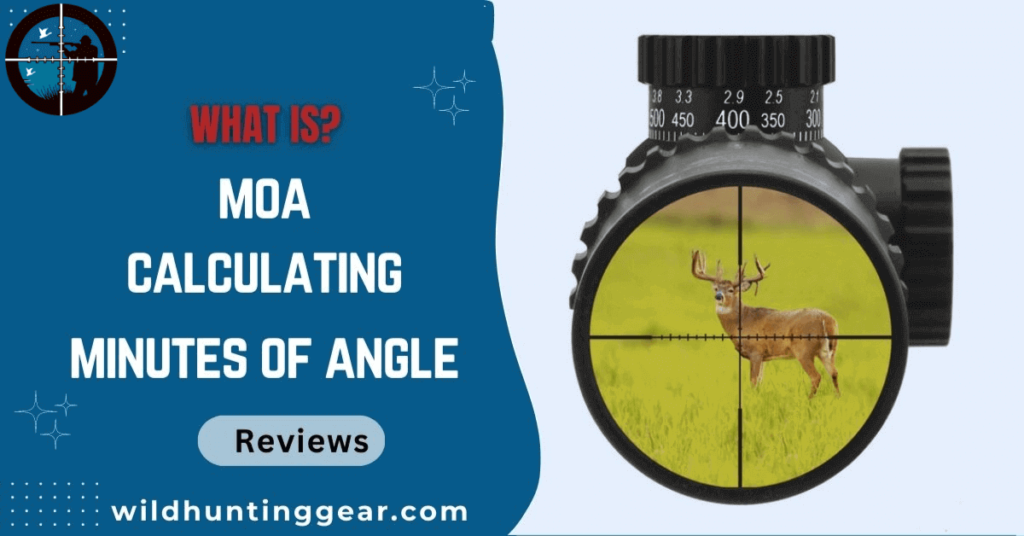If you want to shoot with precision, understanding MOA (Minutes of Angle) is crucial. MOA is a unit of angular measurement that is used to adjust rifle scopes. When it comes to accurate long-range shooting, knowing how to calculate MOA and adjust your turret accordingly is essential for success.
In this blog post, we’ll break down all the basics that you need to know about MOA, what exactly they are, how to accurately calculate them and how they can help improve your accuracy at long ranges when making turret adjustments. So stay tuned to learn everything about “What Is MOA? Calculating Minutes Of Arc & Making Turret Adjustments.

Understanding MOA
A. Definition of MOA:
Minute of Angle (MOA) is a unit of angular measurement commonly used in fields such as shooting, ballistics and optics. It is derived from the concept of dividing a circle into 360 degrees, where each degree is further divided into 60 minutes. In this context, 1 MOA represents 1/60th of a degree.4
B. Relationship between MOA and angular measurements:
To understand the relationship between MOA and other angular measurements, we need to consider the following conversions:
1 degree = 60 minutes1 MOA = 1/60th of a degree1 MOA = (1/60) x (1/60) = 1/3600th of a degree
Therefore, 1 MOA is equivalent to 1/3600th of a full circle. It provides a precise way to measure small angles and make adjustments based on minute changes.
C. Relationship between MOA and target size:
The MOA measurement is also used to calculate the size of a target at different distances. This is necessary because of the way bullet trajectory changes with distance. At longer ranges, a few inches in terms of linear measurement can actually represent several MOAs in terms of angular measurement.
For example, if you are shooting at a target that measures 1 inch from edge to edge at 100 yards, you can calculate how big it will appear at a different distance. To do this, simply multiply the linear size of the target (1 inch) by 1/MOA corresponding to the new range.
For instance: If you are shooting at 200 yards, your target would appear as 2 inches in size (1 inch x 2 MOA). Likewise, if you are shooting at 300 yards, your target would appear as 3 inches in size (1 inch x 3 MOA).
D. Converting MOA to degrees and radians:
In some cases, the MOA measurement may need to be converted into degrees or radians. To do this, simply multiply the MOA value by 0.0165 to get its equivalent in degrees. Similarly, to convert it into radians, multiply the MOA value by 0.000290888.
For instance: If you want to convert 1 MOA to degrees, simply multiply it by 0.0165. The result will be 0.0165 degrees (1 x 0.0165 = 0.0165). Similarly, if you want to convert 1 MOA to radians, simply multiply it by 0.000290888 and the result will be 0.000290888 radians (1 x 0.000290888 = 0.000290888).
E. 1 MOA size:
Now that we understand the basics of MOA, let’s take a look at how big 1 MOA is at various distances. This chart shows the size of 1 MOA at different ranges in both linear and angular measurements:

| Distance | Linear Size (inches) | Angular Measurement (MOAs) |
| 100 yards | 1.0 | 1 |
| 200 yards | 2.0 | 2 |
| 300 yards | 3.0 | 3 |
| 400 yards | 4.0 | 4 |
| 500 yards | 5.0 | 5 |
As you can see from the chart, the size of 1 MOA increases with distance. This means that if you are shooting at a target that appears to be 1 inch in size at 100 yards, it will appear as 2 inches in size at 200 yards and 3 inches in size at 300 yards and so on.
Related Article: 1000 yard rangefinder
Calculating Minutes of Angle

Now that we know what MOA is and how it relates to angular measurements, let’s take a look at how to accurately calculate them.
Basic formula for calculating the Minute of Angle (MOA)
The basic formula for calculating the Minute of Angle (MOA) is:
MOA = (S / D) * 60
Where:
- MOA is the Minute of Angle.
- S is the size of the target or the spread of shots in inches.
- D is the distance to the target in yards.
This formula allows you to determine the angular measurement in minutes of arc that corresponds to a given size or spread at a particular distance. The result is expressed in MOA, which is a unit of angular measurement often used in shooting sports and firearms.
For example, let’s say you have a target that measures 10 inches in diameter and you are shooting at a distance of 100 yards:
MOA = (10 / 100) * 60
= 0.1 * 60
= 6 MOA
In this case, the target’s size of 10 inches at a distance of 100 yards corresponds to an angular measurement of 6 MOA.
MOA calculations for distance and target size:
The first step in calculating MOA is to determine the linear distance between you and your target. Once you have determined the distance, use the formula below to calculate the size of your target in inches at that distance:
Target Size (inches) = Distance (yards) x MOA (minutes).
For example, if you are shooting at 500 yards and your target measures 1.5 inches from edge to edge, you would calculate the size of your target using the following equation:
Target Size (inches) = 500 x 1.5 MOA = 750 inches.
Once you have determined the size of your target in inches, you can then use the formula below to calculate the number of MOAs corresponding to the size of your target:
MOA (minutes) = Target Size (inches) / Distance (yards).
Using our example above, if you are shooting at 500 yards and your target is 1.5 inches in size, you would calculate the number of MOAs using the following equation:
MOA (minutes) = 750 inches / 500 yards = 1.5 MOAs.
In this example, the size of your target is equal to 1.5 MOAs at 500 yards. This means that when you make adjustments to your scope, you should adjust it by 1.5 MOAs for every 100 yards beyond 500 yards in order to maintain accuracy.
Common mistakes to avoid when calculating MOA
- Not accounting for the curvature of the earth: The MOA calculation assumes that you are shooting on flat ground and does not take into account the curvature of the earth. Therefore, it is important to keep in mind that long-range shots will need to be adjusted for elevation even when using MOA calculations.
- Failing to account for bullet drop: Bullet drop must also be taken into consideration when calculating MOA. Bullets will lose energy and velocity over time, which causes them to fall at an angle in relation to the line of sight. As such, it is important to factor in bullet drop when making scope adjustments with MOA.
- Calculating too precisely: It is important to keep in mind that MOA calculations are only an estimate and should not be used for precision shooting. The actual size of the target at any given distance can vary slightly due to various factors such as wind, temperature and humidity. Therefore, it is best to use MOA calculations as a guideline rather than an exact measurement.
- Misunderstanding the unit of measurement: It is also important to note that MOA is an angular unit of measurement and not a linear one. Therefore, when calculating the size of a target using MOA, you must remember to take into account the distance between you and your target.
This will ensure that you are getting an accurate measurement that takes into consideration both the linear size of the target and its angular size at a given distance.
By understanding these common mistakes and avoiding them while calculating MOA, you can ensure that your scope adjustments are accurate and precise. With practice and experience, you will be able to hit your target with greater accuracy than ever before!
Practical tips for accurate MOA calculations
Here are some practical tips for accurate MOA (Minute of Angle) calculations:
- Measure distances accurately: Use a reliable rangefinder or measure the distance to the target accurately. Small errors in distance measurement can lead to significant differences in MOA calculations.
- Precisely measure group size: Measure the size of the group (bullet impact pattern) on the target in inches. Measure from the two widest shots, typically center to center.
- Convert measurements consistently: Ensure that all measurements (distance and group size) are in the same units. For example, if the distance is in yards, the group size should also be measured in inches.
- Round off appropriately: When calculating MOA, round off the final result to the appropriate decimal place. Most shooters use 1/4 MOA or 1/8 MOA increments, depending on the equipment being used.
- Double-check calculations: Verify your calculations to minimize errors. It’s always a good idea to recheck the formula and calculations to ensure accuracy.
- Practice and gain experience: The more you practice calculating MOA, the better you’ll become at estimating the adjustments needed for accurate shooting. Regular practice helps improve your understanding of the concept and builds confidence.
Remember, MOA calculations are meant to assist in making precise adjustments but factors such as wind, bullet drop and the shooter’s skill also play significant roles in hitting the target accurately.
Related Article: How far can you see with binoculars?
How to make turret adjustments using MOA?

Introduction to turret adjustments on telescopic sights:
Turret adjustments are an important feature of many telescopic sights. These adjustments allow the shooter to adjust the reticle of the scope to compensate for bullet drop, wind drift and range errors.
By adjusting the turrets on your scope, you can ensure that your shots land exactly where they’re supposed to. Turrets can be adjusted either in clicks or minutes of angle (MOA) and the adjustment range of each scope varies.
It is important to understand how turret adjustments work in order to get the best performance out of your scope.
Types of turret adjustments:
Turret adjustments can be broadly categorized into two main types: Elevation and windage adjustments control the vertical movement of the reticle, compensating for bullet drop at different distances.
Windage adjustments, on the other hand, manage the horizontal movement of the reticle, compensating for wind drift.
By manipulating the elevation and windage turrets, shooters can align the reticle with the desired point of impact, effectively adjusting their aim to compensate for external factors.
Understanding MOA clicks and their relationship with turret adjustments:
Minute of Angle (MOA) is a unit of angular measurement commonly used in shooting. MOA clicks refer to the increments by which you can adjust the turrets on your telescopic sight. Each click represents a specific angular value, typically 1/4 MOA or 1/8 MOA, depending on the sight.
For example, a 1/4 MOA click means that each adjustment click will move the bullet impact point by 1/4 inch at 100 yards. Similarly, 1/8 MOA clicks would move the impact point by 1/8 inch at the same distance. Understanding the relationship between MOA clicks and their corresponding bullet movement is vital for making precise turret adjustments.
Steps to make turret adjustments using MOA
1) Determine the needed adjustment: To make a turret adjustment using MOA, you must first determine the needed adjustment. This can be done by measuring the difference between where your shot landed and where it should have landed (using a spotting scope or rangefinder).
2) Calculate distance to target: Once you have determined the needed adjustment, calculate the linear distance between you and your target. This is important because the size of your target in inches at a given distance is dependent on the linear distance between you and your target.
3) Calculate MOA adjustment: Use the formula below to calculate the number of MOAs needed for the adjustment:
Adjustment (MOA) = Difference (inches) / Distance (yards).
For example, if the difference between your shot and its intended impact point is 2 inches at a distance of 500 yards, you would calculate the number of MOAs for the adjustment using the following equation:
Adjustment (MOA) = 2 inches / 500 yards = 0.004 MOAs.
4) Make turret adjustments: Once you have calculated the number of MOAs needed for the adjustment, make the appropriate adjustments to your scope. Most scopes will have a dial or knob that you can use to adjust the turrets in MOA increments. As a rule of thumb, one click on the turret typically equals 1/4 or 1/8 MOA depending on your equipment.
5) Horizontal adjustment: After making the necessary vertical turret adjustments, you should also make any necessary horizontal adjustments. To do this, simply rotate your scope to the left or right until you are on target.
6) Vertical adjustment: Once you have made the necessary horizontal adjustments, fine-tune your vertical aim by moving the turret up or down in 1/4 or 1/8 MOA increments.
7) Test your adjustments: After making all of the necessary adjustments, it is important to test your scope. This can be done by shooting at a target from the same distance and comparing the results of your adjustments. If you are still missing the mark, make additional adjustments until you are satisfied with the results.
With practice and experience, you will become more proficient at making turret adjustments using MOA calculations. As your skills improve, so too will your accuracy and precision when shooting!
Final Words:
MOA is a unit of measurement that helps shooters compensate for bullet drop and windage. By breaking down degrees into smaller increments, MOA allows for precise adjustments in minutes and seconds.
To calculate MOA, divide the target’s size or distance by the number of MOA clicks on the scope. Making turret adjustments involves understanding the direction and amount of correction needed, based on the bullet’s point of impact relative to the desired target.
With practice and familiarity, shooters can effectively utilize MOA to fine-tune their shots and improve accuracy in various shooting scenarios. Remember, mastering MOA and turret adjustments requires practice, patience and a thorough understanding of the equipment being used.




